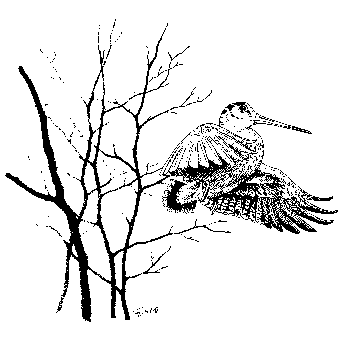American Woodcock
Scolopax minor

Habitat: Young second-growth hardwood forests, shrubby areas, and open habitats such as old fields, forest clearings, bogs, and blueberry fields. Usually associated with moist areas such as streams, marshes, wet meadows, etc.
Weight: Males to six ounces; females to eight ounces.
Length: 11 inches
Food: Most of the woodcock's diet consists of earthworms; however, other food may include seeds, slugs, and various insects (ants, beetles, larvae).
Identification: The American woodcock is a short-legged, plump bird, with a two-and-a-half inch long bill, which it uses to probe the soil in search of earthworms. The bill is flexible and can be opened near the tip even when it is beneath the ground surface. The bill tip contains numerous nerve endings, presumably to aid in detecting movement of prey. The woodcock's head is gray and brown with black bars across the crown. Its large eyes are set high and far back on the head for increased peripheral vision, and the wings are short, wide, and rounded to facilitate flying in dense cover. The mottled brown back, which resembles a "dead-leaf pattern", provides excellent camouflage against the forest floor. Sexes are similar in appearance, but the female woodcock is slightly larger than the male.
Range: The woodcock's range is primarily eastern North America from southern Canada to the Gulf states. The birds breed in the northern part of their range and migrate south in the winter.
Reproduction: In late January and February, woodcock begin to migrate north, arriving in the Northeast from mid-March to early April to begin courtship and breeding. Shortly after their arrival, males begin performing courtship flights at dusk in forest openings called "singing grounds". The display consists of a series of spiraling flights interspersed with ground-strutting during which the male utters a nasal "peent" repeatedly. Each evening's activities may last 30 to 60 minutes and may consist of 10 to 20 such performances. The singing ground is a relatively open area containing scattered brush, small trees, and shrubs. Singing grounds have also been observed in grazed pastures and fields.
A male may mate with several females; nesting begins in April and May. The nest is a shallow depression lined with leaves, usually located less than 100 yards from the singing ground and constructed in young stands of hardwoods or mixed hardwoods and conifers. It is often positioned at the base of a small tree or shrub. Four brown, pink, and gray, mottled eggs are laid and incubated for 19 to 22 days. The females hold tight on the nest, relying on their protective coloration, and flushing only when almost touched. They are responsible for incubation and care of the chicks. The young leave the nest one day after hatching and follow the female throughout the feeding area. Fully feathered and capable of flying at two weeks of age, young woodcocks mature quickly and appear almost full grown at four weeks. They tend to remain in the nesting area until the fall migration begins in October.
History in Connecticut: The history of the American woodcock in Connecticut has reflected the changes seen in the landscape through the last centuries. The abundance of woodcock is related to the availability and quality of four habitat types:
- Open areas, such as old fields, forest clearings, and bogs. These areas are used for courtship in the spring and nighttime roosting during the summer and early fall.
- Young, open hardwood stands dominated by seedlings and saplings for nesting and brood rearing.
- Young hardwood stands with a dense overstory and somewhat clear understory. These areas are used by both young and adult birds for feeding and resting in the daytime.
- Alder swales and surrounding second-growth hardwood types on fertile, moist soil with an abundant supply of earthworms for feeding.
In the northeastern United States, old farms reverting to forests often contain a diversity of cover types. These areas provide some of the best habitat in the Northeast. However, the amount of this type of habitat has declined and is expected to continue to do so.
Woodcock are particularly vulnerable to changes in habitat. Habitat loss through urbanization and forest maturation appears to be the major reason for the decline in population numbers. The drainage of wetlands and natural plant succession can eliminate valuable woodcock habitat, forcing the birds to utilize marginal areas or move in search of new habitats to occupy.
Interesting Facts: The American woodcock, also known as "timber-doodle", is a bird of the forest despite its classification in the sandpiper family. During the summer months, woodcock are primarily active during the daylight hours, feeding and resting in pole-sized hardwood, mixed hardwood and conifer, or alder stands. These areas generally have dense overhead cover, fairly open ground cover for good visibility, and moist fertile soil which supports earthworms. At dusk, the birds walk or fly to open fields or forest clearings where they roost on the ground.
 The Technical Assistance
Informational Series is 75 percent funded by Federal Aid to Wildlife Restoration -
Pittman-Robertson (P-R) Program. The P-R Program provides funding through an excise tax on
the sale of sporting firearms, ammunition, and archery equipment. The remaining 25 percent
of the funding is matched by the Connecticut Wildlife Division. (rev.12/99)
The Technical Assistance
Informational Series is 75 percent funded by Federal Aid to Wildlife Restoration -
Pittman-Robertson (P-R) Program. The P-R Program provides funding through an excise tax on
the sale of sporting firearms, ammunition, and archery equipment. The remaining 25 percent
of the funding is matched by the Connecticut Wildlife Division. (rev.12/99)

